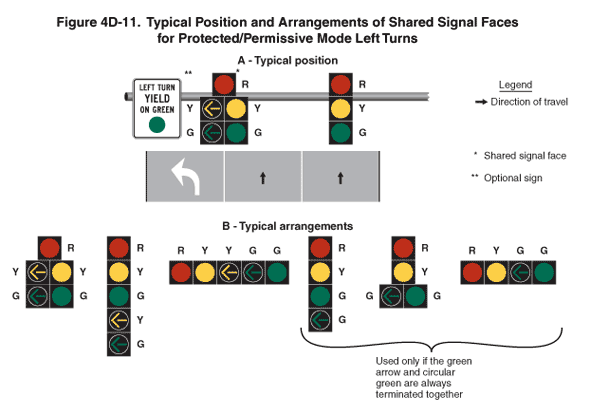2009 Edition Part 4 Figure 4D-11. Typical Position and Arrangements of Shared Signal Faces for Protected/Permissive Mode Left Turns

Figure 4D-11. Typical Position and Arrangements of Shared Signal Faces for Protected/Permissive Mode Left Turns
This figure shows the typical position and arrangements of shared signal faces for protected/permissive mode left turns. A legend shows a black arrow indicating the direction of travel on the roadway.
The figure shows two types of examples. The first example is labeled "A – Typical Position." It shows a sign and two signals aligned horizontally on a horizontal pole over a vertical segment of three lanes of a roadway. A white left-turn arrow is shown marked in the left lane, and upward-pointing black arrows in the center and right lanes denote the direction of travel as straight through. The left signal (noted as a shared signal face) is shown above the white line separating the left and center lanes as a vertical arrangement of a circular red signal indication above a horizontal arrangement of a left-turn yellow arrow to the left of a circular yellow signal indication above a horizontal arrangement of a left-turn green arrow to the left of a circular green signal indication. To the left of the left signal is shown a vertical rectangular white sign with a black border and the words "LEFT TURN YIELD ON GREEN" in black above a green disk and this sign is labeled optional. The right signal is shown above the right lane as a vertical arrangement of circular red, circular yellow, and circular green signal indications.
The second type of example is labeled "B – Typical Arrangements." It shows the following six arrangements:
- A vertical arrangement of a circular red signal indication above a horizontal arrangement of a left-turn yellow arrow to the left of a circular yellow signal indication above a horizontal arrangement of a left-turn green arrow to the left of a circular green signal indication
- A vertical arrangement, from top to bottom, of circular red, circular yellow, circular green, left-turn yellow arrow, and left-turn green arrow signal indications
- A horizontal arrangement of circular red, circular yellow, left-turn yellow arrow, left-turn green arrow, and circular green signal indications
- A vertical arrangement of circular red, circular yellow, circular green, and left-turn green arrow signal indications, noted as "used only if the green arrow and circular green are always terminated together"
- A vertical arrangement of a circular red signal indication, a circular yellow signal indication, and a horizontal arrangement of a left-turn green arrow to the left of a circular green signal indication, noted as "used only if the green arrow and circular green are always terminated together"
- A horizontal arrangement of circular red, circular yellow, left-turn green arrow, and circular green signal indications, noted as "used only if the green arrow and circular green are always terminated together"
